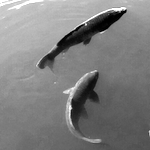Birds are believed to fly in groups for a variety of reasons, including reducing predation risk, improving navigation, and reducing the cost of flight by taking advantage of the wake of individuals ahead of them. This last possibility has long been an explanation for the V and echelon formations adopted by some larger, often migratory, species. Theoretical treatments of formation flight suggest followers could save 15 to 40% of flight costs. These savings depend on positioning, with leader-follower lateral distances of 1.0 to 0.74 wingtip-to-wingtip spans providing the greatest benefit. Small birds typically form cluster flocks, and biomechanical correlates suggest these groups likely increase flight costs, although evidence from shorebirds shows such flocks include small-scale V formation motifs. Heart rate monitoring of pelicans flying in V formation estimated an energy savings of 11-14%, but no similar metabolic proxy data exist for smaller birds, and no study has directly measured the metabolic benefit or cost of group flight in any species.
Here we show that European Starlings flying in small groups in a wind tunnel adopt, on average, V formation positioning with a modal spanwise and streamwise spacing of [0.81, 0.91] wingspans. Followers in this position saved 31% of their solo flight costs as measured via CO2 turnover, but followers distant from it experienced additional flight costs up to 39% above their solo benchmark. Thus, our results show energetic costs or benefits for group flight based on the details of individual interactions. We also found that group leadership was related to flight efficiency, with the most efficient birds in solo flight being more likely to take a lead position. These results demonstrate physiological measurement of costs and benefits in group flight and establish a path for experimental investigation of wake interaction and group flight aerodynamics in birds.

 PDF version
PDF version
